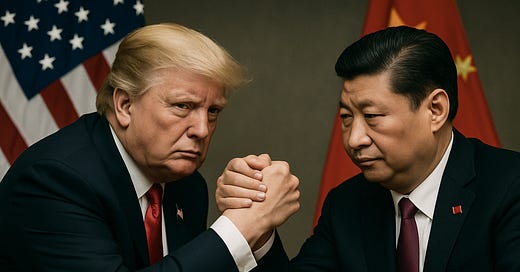Growth Dragons Weekly: US Trade War’s True Goal Revealed — Isolate China, But China Strikes Back
What happened in China this week:
US Global Trade War Aim Revealed: Isolating China, But China Strikes Back
China Suspends Boeing Deliveries as Trade War Escalates — But C919 Isn’t Ready Yet
CATL’s Profit Jumps 33% in Q1 2025
Alibaba Expands AI Partnership to Nio and BMW
China’s Largest Energy Drink Player, Red Bull’s Rival, Files for Hong Kong IPO
#1 US Global Trade War Aim Revealed: Isolating China, But China Strikes Back
The Trump administration’s latest offensive against China is escalating into a full-blown global economic war. Tariffs on some Chinese imports have been raised to a staggering 245%, while Washington is pressuring over 70 allied nations to economically isolate Beijing. According to The Wall Street Journal, the strategy is twofold: block Chinese firms from bypassing tariffs through third countries, and cut the world’s reliance on Chinese industrial goods. Treasury Secretary Scott Bessent is reportedly leading efforts to rally international support, framing it as a prelude to direct negotiations with President Xi Jinping. Yet even within Washington, there’s no clear consensus on how far these policies should go.
But Beijing isn’t sitting back to let its global trade be strangled.
China scored a diplomatic win by normalizing trade ties with Australia, lifting bans on red meat, barley, wine, timber, and coal. It is also actively engaging ASEAN and Europe on trade deals and EV tariff talks. These moves show that China is not just defending its turf—it’s adapting, diversifying, and keeping vital commercial relationships alive.
US Restricts Nvidia H20 AI Chips to China — Jensen Huang Rushes to Beijing
Nowhere is the new economic cold war more intense than in technology. Nvidia’s H20 AI chip—designed specifically to comply with U.S. export rules—has now been barred from sale to China without a license.
Facing this setback, Nvidia CEO Jensen Huang made a surprise visit to Beijing, calling China a “key market” and pledging to design more compliant chips for Chinese clients. Washington’s goal is clear: to choke China’s access to critical AI and semiconductor technology.
But ironically, these curbs could backfire—accelerating China’s own tech self-sufficiency, as seen with breakthroughs from companies like Huawei. Washington might be cutting China off today but planting the seeds for a stronger, independent Chinese tech sector tomorrow.
Chinese Factories Fight Back: Urging Americans to Buy Direct
As traditional trade channels tighten, Chinese factories are getting creative. TikTok and other social media platforms have become a new battleground. Chinese influencers are urging U.S. consumers to buy directly from factories, bypassing tariffs.
Viral videos claiming to offer factory-direct Lululemon leggings or Hermès-style handbags have racked up millions of views. While some products may be counterfeit, the trend highlights two truths:
China’s informal retail and digital marketing machines are incredibly powerful.
American consumers are addicted to cheap Chinese goods.
The impact is real: Taobao surged from 47th to 5th place among free apps in the U.S. Apple App Store within just a few days, according to Sensor Tower. On Google Play, it jumped from 144th to 3rd place in shopping apps.
Protectionism may be rising—but so is Chinese ingenuity.
Economic Outlook: Solid Start, But Storm Clouds Ahead
Despite these mounting pressures, China’s economy grew a better-than-expected 5.4% in Q1 2025, fueled by strong consumer spending and industrial output. Retail sales rose 5.9%, and factory production surged 7.7% in March.
But quarterly GDP growth slowed to 1.2%, and headwinds are gathering:
Deflation risks
High youth unemployment
Persistent property sector woes
Tariffs hitting exports
Global banks are dialing down expectations:
UBS cut its 2025 forecast to 3.4%, citing weakening exports.
Nomura slashed its projection from 4.5% to 4%.
ANZ lowered its estimate to 4.2%.
UBS even warned that U.S. tariffs alone could shave over two percentage points off China's GDP this year.
Many expect China to cut interest rates to cushion the blow. But we believe rate cuts aren’t imminent.
The environment is too volatile—rushed monetary moves could backfire.
The USD is weakening, reducing pressure on the yuan and buying China time.
The European Central Bank has already cut rates, making China’s higher rates relatively more attractive to foreign capital.
Instead, China is more likely to lean on fiscal spending, especially boosting durable goods consumption and housing stimulus, to keep growth afloat.
The U.S.-China trade war today is the gravest external threat to China’s economy in decades. But Beijing’s response shows a shift—from defensive retaliation to active reinvention.
This isn’t just about tariffs anymore. It’s about who can outlast and outmaneuver the other.
Who will break first?



